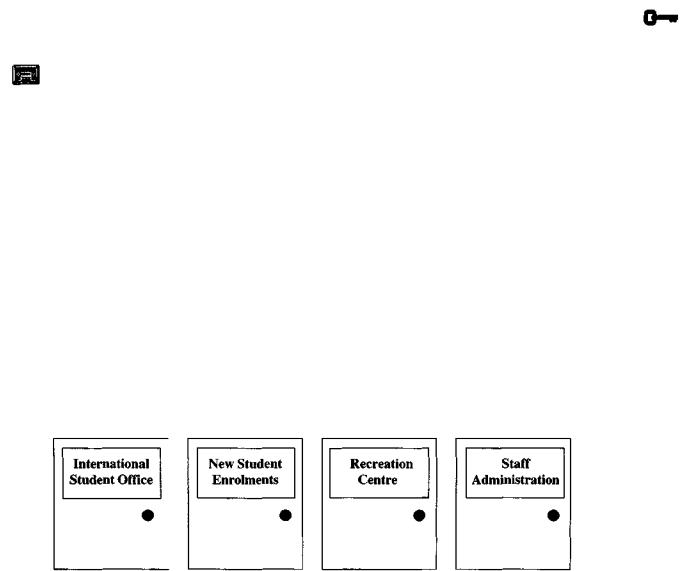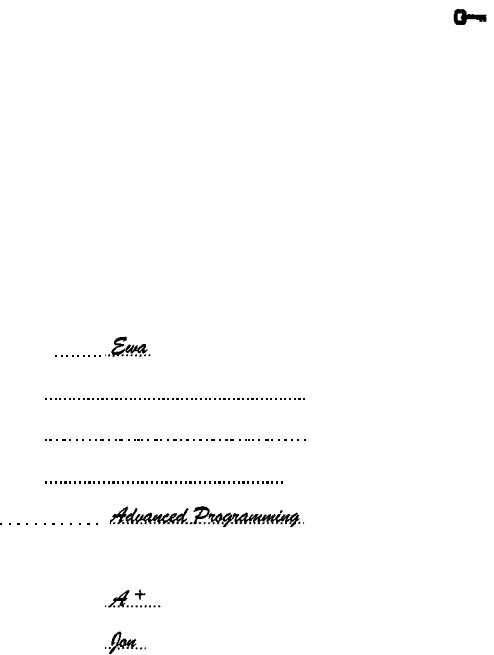
Helpful_Hints_for_IELTS
.pdf
Practice Test One
©PRACTICE SPEAKING TEST ONE
Practise answering the questions below, giving answers that are at least one or two sentences long (ifnot more). Ifpossible, practise with another person - taking it in turns to answerthe same question - and compare your responses.
(Please note that thefollowing questions are only a guide to the type ofquestions you might be asked in the actual test.)
Part 1 |
87-9i |
Please enter and take a seat. Yes, just here. First, I need to see your passport. |
|
... it's only for security purposes. |
|
Thank you. My name is (interviewer's name). And yours is ...? |
|
So, I see you are from (your country). |
|
Can you tell me about the town you come from? |
|
Has your family always lived in (your town)l |
|
Where are you living now? |
|
How often do you contact your parents? |
|
Do you have any brothers and sisters?
Can you tell me what you are studying or where you are working at the moment? What do you like about the work or study you are doing?
Describe your school or workplace.
What is (or was) your favourite subject at school? Why?
What hobbies do you have if any?
Why do you enjoy this activity (these activities)?
What do you do and where do you go when you get together with your friends? What kind of holidays do you like?
What sports do you play or like to watch?
What type of books do you enjoy reading?
Is there anything you find difficult in your present life? •
105

|
101 Helpful Hints for IELTS |
|
|
92-94 |
Part 2 |
|
|
|
Thank you. Now I'd like you to take this card. I want you to speak for one or two minutes about |
||
|
the topic written on this card. Follow the instructions. I will give you one minute to prepare |
||
|
before I ask you to give your talk. |
|
|
|
|
|
|
S-95 |
|
Talk about a library that you belong to or have visited. |
|
|
|
You should say: |
|
|
|
where it is located and how the library is organised |
|
|
|
who visits the library and why people go there |
|
|
|
when and why you last visited the library |
|
|
|
... and what rules the library has. |
|
|
|
|
|
95-99 |
P a r t 3 (begins after one or two follow-up questions on the talk above) |
|
|
|
Please hand me the card. Thank you. Libraries have always been very important to the |
||
|
community and especially to students. |
|
|
|
As well as lending books to borrowers, what other services are provided by a good library? |
||
|
Does a library serve any other function in the communinty? |
|
|
|
How has access to information changed over the last hundred years or so? |
|
|
|
What are the advantages of using the Internet over visiting a library? |
|
|
|
Are there any advantages of using a library in preference to searching the Internet? |
|
|
|
Do you think that the Internet disadvantages some people over others? In what way? |
|
|
|
Many people cannot read or write well in their own language. How can this be solved? |
|
|
|
People are reading less and less these days^ why do you think this is? |
|
|
|
How can people be encouraged to read more? |
|
|
|
What about electronic books - do they have a future? |
|
|
loo-ioi |
That is the end of the interview. Thank you and goodbye. |
|
|
OverallCheck. |
|
|
|
WhatToDoand |
|
That is the end of Practice Speaking Test One. |
m |
WhatNotToDo |
|
|
|
88-93-96-101 Check your answers to Practice Test One with the Answer Key on page 160.
106

PRACTICE TEST TWO
PRACTICE LISTENING TEST TWO
Practice Test Two
Pre-Test:
1-5
DunngTest:
6-10
Thisis apracticelisteningtestthatresembles theInternationalEnglishLanguageTesting System Listening Test. The test consists of four sections. Answer the questions as you listen to the recording. Note that the recording is played once only.
Section 1
Q u e s t i o n s |
1-2 |
Decide which picture is the best match with what you hear on the tape, and circle the letter under that picture. The first one has been done for you as an example.
Example: Where is Ewa?
8
16-17
9
A  C D
C D
Q1. Which timetable does Ewa decide upon for Friday?
MORNING: |
MORNING: |
MORNING: |
MORNING: |
Reading Skills |
Vocabulary |
Writing Skills |
Grammar |
Writing Skills |
Speaking Skills |
Reading Skills |
Reading Skills |
Pronunciation |
Reading Skills |
Grarnmar |
Writing Skills |
AFTERNOON: |
AFTERNOON: |
AFTERNOON: |
AFTERNOON: |
Listening Practice |
Grammar |
Listening Practice |
No Electives |
Speaking Skills |
Writing Skills |
Vocabulary |
|
A |
B |
c |
D |
18-19
20
107

|
101 Helpful Hints for IELTS |
18-22 |
Q2. Which clock shows the time of Ewa's special English class? |
8
20
19-21
3 1
19-20
A B C D
Questions |
3-7 |
|
|
|
Circle the correct answer from the choices given below each question. |
||||
Q3. |
How long has Jon been studying at the college? |
|||
|
a) |
one year |
c) |
one and a half years |
|
b) |
two years |
d) |
two and a half years |
Q4. |
What course is Ewa going to study at the college? |
|||
|
a) |
Basic Computing |
c) |
Basic Programming |
|
b) |
Advanced Programming |
d) |
Advanced Computing |
Q5. What is the combined number of students and staff at the college? |
||||
|
a) |
150 |
c) |
50 |
|
b) |
550 |
d) |
500 |
Q6. |
Which club does Jon belong to at the college? |
|||
|
a) |
Hang Gliding Club |
c) |
Tennis Club |
|
b) |
Photographic Club |
d) |
none of the above |
Q7. |
How much does Jon think Ewa will pay to join the Orienteering Club? |
|||
|
a) |
£20 |
c) |
£50 |
|
b) |
£10 |
d) |
£15 |
108

Practice Test Two
Questions 8-14
Fill in the information you hear on the form below in the spaces numbered 8 - 14 .
The first one, has been done for you as an example.
16-17
23
NATIONALBUSINESSCOLLEGE
ORIENTEERING CLUB: REGISTRATION FORM
Given Name: (Example:) |
|
|
9 |
|
Family Name: |
(8) |
|
|
14-15-19 |
|
|
|
|
20 591 |
Nationality: |
(9) |
|
|
15-19 591 |
Student Number: |
(10) |
|
7. |
15-19 |
Present Course: |
|
|
|
|
Years of Experience: |
(11) |
|
15 |
|
Blood Type: |
|
|
|
|
Partner's Given Name: |
|
|
|
|
Partner's Family Name: |
(12) . |
|
14-15-59* |
|
Day of Session: |
|
(13). |
|
59 1 |
Home Telephone No.: |
(14) . |
|
15-19 |
|
|
|
|
|
Check- |
|
|
|
|
11-15 |
109

|
101 Helpful Hints for IELTS |
610 |
Section 2 |
23-25 |
|
8
16'17
Questions 15 -18
You will now hear a short report broadcast on the television. Look at the map of Estonia and complete the sentences below with the correct number, word or phrase according to what you hear. The first one has been done for you as an example.
Tallinn
ESTONIA
9 |
Example: |
Estonia is located on the |
&M&&f:. shores of the Baltic sea. |
is |
Q15. |
The country is only |
square km in size. |
20 |
|
|
|
|
Q16. |
Estonia is about |
the size of Scotland. |
|
Q17. |
The percentage of native Estonians is |
|
|
Q18. |
Tallinn is the |
city of Estonia. |
8-23
25
9
Questions 19 - 23
Complete the summary of part two of the television programme by writing NO MORE THAN TWO WORDS for each answer. The first one has been done for you as an example.
Estonia is a small, flat country in Europe dotted with numerous islands and
...(Example:)....fa&€4. The manufacture of agricultural machinery and
12-65' |
(19) |
are the major industries, with (20) |
and vegetables |
the main (21)
Once a part of Greater Russia, the nation is now an independent democratic
(22) |
The Kroon is the unit of currency; the official language is |
Estonian. The weather in Estonia in summer is (23)
Check:
11-15
110

Practice Test Two
Section 3 |
6-io |
|
Questions 2432 |
|
23-26-29 |
|
|
|
You will hear an interview with an ex-student of the college. |
Write a word or a short phrase |
|
to answer each of the questions below. The first one has been done for you as an example. |
16"1 |
|
Example: How many years ago was Anna a student at the college?
Q24. |
Who does Anna currently work for? |
|
Q25. |
Why are some elderly people provided with food by the council? |
|
Q26. |
When did Anna discover her progress in the first course was unsatisfactory? |
|
Q27./Q28. |
Name two of the suggestions made to Anna by the school counsellor: |
7 |
|
(1) |
|
|
(2) |
|
Q29. |
What does Anna do to increase her English vocabulary? |
|
Q30. |
According to Anna, does eating earlier in the day increase the metabolic rate? |
|
Q31. |
Why does Anna wish to get a job in a hospital soon? |
|
Q32. |
What is Anna's long-term goal? |
|
|
|
Check: |
|
|
11-15 |
111

6-10
34-35
8
16-17
34
20
34
34
35
35
101 Helpful Hints for IELTS
Section 4
Questions 33 - 40
You will hear part of the Student Orientation to the computer laboratory.
Circle |
A |
if the information in the statement is Accurate |
|
I |
if the information in the statement is Inaccurate |
|
N |
if the information in the statement is Not Given |
The first one has been done for you as an example.
Your Answers
Example: |
There are over 100 computers in the laboratory. |
I |
I |
N |
Q33. |
Students only need to enter their name to log on to the machines. |
A |
I |
N |
Q34. |
If something goes wrong on a computer, you should not turn the |
A |
I |
N |
|
machine off. |
|
|
|
Q35. |
Student computer disks are sometimes allowed in the laboratory. |
A |
I |
N |
Q36. |
The Macintosh computer network can only be used by second |
A |
I |
N |
|
and third year students. |
|
|
|
Q37. |
After class hours there is a charge per page for the use of all |
A |
I |
N |
|
computer printers. |
|
|
|
Q38. |
The computer laboratory is open at 8.00 am during the week. |
A |
I |
N |
Q39. |
The computer lab card shows a student's name, course and |
A |
I |
N |
|
log on number. |
|
|
|
Q40. |
Students are expected to follow 5 computer laboratory rules. |
A |
I |
N |
OverallCheck:
Blanks: 11
Grammar 12
&65
One Answer 13
Spelling: 14
Legibility: IS
Punctuation: 591
That is the end of Practice Listening Test Two.
You now have 10 minutes to transfer your answers to the Answer Sheet. Then continue with Practice Reading Test Two on page 113.
112

|
Practice Test Two |
PRACTICE READING TEST TWO |
DunngTest |
|
6-10-37 |
Reading Passage 1 |
|
Questions 1-15
You are advised to spend about 20 minutes on Questions 1-15.
TRACKING HURRICANES
38-44
54-56-57
North American meteorologists from the National Oceanic and Atmospheric Administration (NOAA)'s Hurricane Research Division have recently improved the success rate in
their forecasting of where hurricanes are likely to hit land by an estimated 15 to 30%. This increase in accuracy is due to the use of instruments called GPS-dropwindsondes, which can probe the atmosphere surrounding a hurricane while it is still out at sea. The atmospheric characteristics of hurricanes over land are well understood because investigation is possible with weather balloons containing sophisticated meteorological instruments. When hurricanes are out of reach of balloons, gathering information is decidedly more difficult. Little is known of the weather conditions that guide hurricanes towards land.
An accurate estimation of where a hurricane will strike is essential in order to reduce loss of life and property. Hurricane Andrew, the most costly hurricane in U.S. history, killed 15 people and caused damage of $35 billion, in today's dollars, in 1992. However, the unnamed: Category 42 hurricane which struck southeast Florida in 1926 and killed 243 people would have caused an estimated $77 billion if it had struck today. The reason for this is the explosion in population growth and development along the south-east coast of the U.S. during the last half century.
Hurricanes occur in cycles every few decades, the last intense period in the U.S. being from 1940 to 1969. 'Camille', a Category 5 hurricane of such catastrophic force that it caused over a billion and a half dollars worth of damage at the time and killed 256 people, struck the coast of the Gulf of Mexico in 1969 with winds over 320 km/h. Yet, for the last quarter century, hurricane activity has been relatively mild. Scientists do not know the precise reason for the cycles of hurricane activity, but they could be caused by a phenomenon called the 'Atlantic Conveyor'. This is the name given to the gigantic current of water that flows cold from the top of the globe slowly along the Atlantic ocean floor to Antarctica and resurfaces decades later before flowing back north, absorbing heat as it crosses the equator. Since hurricanes derive their energy from the heat of warm water, it is thought that an increase in the speed of the' Conveyor', as it pulls warm water to the north, is an indicator of intensifying hurricane activity.
The use of GPS-dropwindsondes began in 1997. Small sensing devices dropped from planes at very high altitudes and over a wide area, they are far more revealing than previously used sensors. Because they weigh only 0.4 kilograms, they are able to stay aloft for longer periods and broadcast more data to the ground. Each sonde carries its own global positioning satellite receiver. The GPS signals received are used to calculate the direction and speed of wind, and data on temperature, humidity, and barometric pressure at half second intervals all the way down to the ocean surface.
113

101 Helpful Hints for IELTS
Dropwindsonde information is fed into a special meteorological computer in Maryland which generates a global computer model of wind patterns. Data analysts have discovered a greater variability in the winds at sea level than previously believed, but many forecasting problems are beyond a solution, at least for the time being. For instance, it is not yet known why hurricanes can suddenly change in intensity; current computer models often fail to predict whether a hurricane will reach land or else cannot pinpoint where a strike will take place.
One surprising result of a recent computer simulation was the destruction of a large part ofdowntown New York. Hurricane researchers believe that the city is more likely than Miami to suffer a direct hit in the near future. Also, certain geographical features of the coastline near New York make it conceivable that a wall of water called a storm surge pushed ashore by hurricane winds would cause a devastating flooding of Manhattan. A storm surge was responsible for the more than 8000 deaths caused by the hurricane that destroyed the city of Galveston in 1900.
1 the custom of naming hurricanes began in the early 1950s
2hurricanes are categorised according to their wind speed from Category 1 (least intense) to Category 5 (most intense)
6
8
26-27
43-57
Questions 1 - 4
You are advised to spend about 5 minutes on Questions 1-4.
Refer to Reading Passage 1 "Tracking Hurricanes", and look at Questions 1 - 4 below. Write your answers in boxes 1 - 4 on your Answer Sheet. The first one has been done for you as an example.
9
65'
56
52-54
54'591
Check:
11-15
Example: What do the letters NOAA stand for?
Ql. Which instruments have recently increased the success rate of U.S. hurricane forecasts?
Q2. What reason is given for the lack of knowledge of hurricanes at sea?
Q3. Why was the hurricane which struck in 1926 not given a name?
Q4. What is the name of the strongest hurricane mentioned in the article?
114
